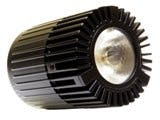Focus on usable light
The two most important things to consider when working with directional light are, firstly, the amount of light reaching the targeted area and, secondly, the quality of that light. “Unless LED products satisfy our intensity, distribution and color rendering expectations, we will not consider installing LED lamps and modules regardless of their efficiency or cost-savings,” says Bradley Bouch, Senior Lighting Designer for Wynn Design and Development. “Designers have been disappointed with LED lights that do not live up to their own specifications, much less the designers' expectations. LED manufacturers should simply take their product and shine it on a wall next to a similar halogen MR16.” He adds, “When the quality of light from the LED lamp is comparable to the halogen lamp and the product is dimmable, we will be happy to use them. We are always looking for ways to improve energy efficiency, but not at the expense of the lighting quality.”
In short, LED lighting manufacturers need to design products with the emphasis on the delivered light, and to provide the necessary specifications that the designer can use to incorporate LED lights into their overall plans.
+++++++
This article was published in the April 2009 issue of LEDs Magazine.
To read the full version of this article, please visit our Magazine page, where you can download FREE electronic PDF versions of all issues of LEDs Magazine.
You can also request a print copy of LEDs Magazine (available by paid subscription) and sign up for our free weekly email newsletter.






